We invite you to explore India - the Land with infinite beauty ! Whether you soar high into Himalayas or peer under the ruins of the Ancient monuments dotting the landscape of India, you will cherish the experience long after your visit ! This India Travel Guide is free from any commercial interest! This site is dedicated to promote India - the vast subcontinent, its glorious past, magnificent landscape and its infinite variety.

Chola Temples
Three temples comprise the great living Chola temples namely the Brihadisvara temples in Thanjavur that was built in the 11th century, the Brihadisvara temple in Gangaikondacholisvaram built in the 11th century and the Airavateswara temple at Darasuram built in the 12th century.
Chola Empire: The Chola Empire influenced vast stretches of land from Madurai to Mekong Valley in Vietnam - spreading Hinduism. This remarkable dynasty ruled for nearly 1500 years in the fertile plains of Tamilnadu - administering the vast expanse of land from Thanjavur as its capital. The Early Cholas established their kingdom from Uraiyur around 235 BC. Inscriptions and Sangam literature speak about the glory of Cholas from this time. Grand Anicut or Kallanai as it is called in Tamil, was built across the river Kaveri around 270 BC by Karikalan - a Cholan King. This oldest surviving dam in the world was later revamped by the British in 19th Century.
Under the Chozha Emperors, temples became the center of importance. Major official ceremonies were held in the temples. Temples became the hub of political, economic and cultural activities. Arts in various form flourished under the Chola Kingdom. Chola empire represented the finest tradition of sculpture, painting, dance, music and literature of the Tamil Culture.
Cholan Empire : Chola Emperors ruled vast swaths of fertile land not only in the Indian Sub-continent but also around south east Asia. Their influence - notably their temple architecture, idols, religion (they worshipped Shiva) and language spread in these regions. Research studies on Chozhan Empire show a strong influence of Chozhan civilization in many parts of south Asia. Thanjavur - Tanjur - one of their latter year capitals was considered as the granary of the South India during the British Raj. Cholans administered the fertile plains of Kaveri river. Their staple diet - rice would be plentiful in all their regions of influence as they chose perennial rivers around their cities. Tamil inscriptions describing their administrations can be found in all these places. Cholans excelled in administering land captured during their conquest. Their Governors collected tax from their subjects and the proceeds helped in the expansion of their empire. Cholan rulers, history tells us, were largely benevolent to their subjects. Cholan armies were primarily used to establish their supremacy over new territories. When the Cholan rulers left, there was not much acrimony against the erstwhile Cholan Empire. e.g.: The Chennakeshava temple in Belur in Karnataka was actually built to commemorate the victory over the Cholan Viceroy in the battle near Talakad. The magnificent Hoysala Temple bears testimony to the fact that the new rulers copied many features of the Cholan temple architecture.
Chola Temples
The Brihadishvara temple at Thanjavur was built by the potent ruler of the Chola dynasty, King Rajaraja Chola in the year 1010 AD. Construction of this magnificent edifice was started in the year 983 AD and was designed to represent a Cosmic structure from Hinduism - Maha Meru, the 'big mountain' or the abode of Shiva. Originally called as the Rajarajeshwaram, this big temple has 2 gigantic sandstone archways. The first one with five tiers is called as the Keralanthagan Thiruvayil meaning the 'the Gateway of the Conqueror of Kerala'. This was in honor of his victory over the Cherans ruling Kerala - early in his reign.
The second archway with 3 tiered structure is called as RajaRajan Thiruvayil named after the Emperor directly.
The main temple at the time of completion in the year 1010 consisted of a Sanctum Sanctorum tower known as Sri Vimana, a big rectangular mandapa with an intervening vestibule known as Mukha Mandapa. The Sri Vimana has a large granite stone structure as the basement to lend structural stability for the massive towers upon it.
The perfect symmetry of the structure, the elaborate arrangement of impeccably sculpted stone figures adorning the outside walls and the visual symphony of the large stones meticulously placed one atop another with amazing mechanical precision - will leave you spellbound.
Chola Temple Architecture
- Brihadishvara temple is a mirror to the exquisite Dravidian architecture and the paintings, letters and the inscription on the temple walls speak of the rich cultural heritage and high literary progress under this dynamic ruler. Emperor RajaRaja Cholan I (literally King of Kings in Tamil) was a great conqueror from South India who established his rule across entire south India - all the way to Kalinga in North East and the southern parts of Chalukya in North West. His empire extended up to Ceylon (now Sri Lanka) in the South. His influence spread across the Bay of Bengal to as far as Java and Sumatra. His reign (AD 985-1014) was prosperous and his administration was efficient.
- Chola Temple Architecture: Dravidian style of architecture reached its zenith under the Chola Kings. Cholan Temple architecture's hallmark is the Vimana Tower surrounded by a richly ornamented Gopuram gateway constructed out of granite stones. Even though the original Chola kingdom was based on the alluvial delta plains of the river Kaveri, Chola Kings managed to quarry and transport hugh monolithic granite blocks from afar probably using their trained elephants. Chola Armies used elephants and horses extensively in their campaigns.
- Chola - devout Shivaites, built Shiva temples which had a Garbagriha where the central deity - Shiva or as is more usual Shiva Lingam is kept, Ardha mandapa - where the luminaries of the day gathered, Maha mandapa - where important functions and cultural events were held. These mandapas were aligned on the east-west axis. Prakara walls surrounded the central edifice. Outer walls of brick and a moat completed the fortifications of the great temples.
- The Brihadisvara temple at Gangaikondachozhapuram was built by another Emperor King Rajendhra Chola, son of Rajaraja Chola between 1020 and 1029 AD. The king after conquering Madurai (Pandyan territory) and Ceylon extended his territory till here and carried water from the river Ganges to purify the local water body thus giving this place the name Gangaikondacholisvaram. His forces occupied parts of Burma (now Myanmar) and Malaya. He later went on to establish his capital in this place and also built a temple resembling the structure of the Brihadisvara temple at Thanjavur. This temple though a little smaller when compared to the temple at Thanjavur reflects the Chalukya architecture and also portrays the Pallava and Chola dynasties. The temple was damaged during the wars and was also used as garrison by the Pandya rulers and later on by the British.
- Airavateswara temple at Darasuram was built by King Rajaraja chola II and is a true representation of the chola dynasty.
These three temples have been declared as a world heritage site by UNESCO. The Brihadisvara temple at Thanjavur was declared as a world heritage site in the year 1987 and the other two temples were declared as world heritage sites in the year 2004. In the year 2010, this temple had its Millennium celebrations.
Brihadisvara temple at Thanjavur
- The greatest architectural monument of the Chola period is the Thanjavoor Brahadeswara Temple. The vimanam or the temple tower is the biggest in the world and measures to a height of seventy meters. The sigaram also known as the crown weighs around 82 tons and is an octagonal cupola carved from a single stone. The Periya koil or the main temple stands inside a fort and is adorned by this temple tower.
- The main deity of the temple is Shivaling a form of Lord Shiva measuring to a height of 8.7 meters. This Shivaling is the largest in the world.
- The stone bull Nandhi is another attractive feature and weighs 27 tons. This Nandhi is the second largest in the world and its size is truly breathtaking. The area in which the Nandhi is covered by a ceiling that includes artwork in the archetypal Thanjavur style.
- Life size idols of Goddess Lakshmi, Durga and Saraswathi can be found on the walls of the inner passage. There are idols of Lord Nataraja and Ardhanariswara too. The granite structure of the temple is elaborate and grand. The painting and the murals all speak of the Chola dynasty and their love for art and architecture.
Chola Art
As we have seen, the Chola Kings were great patrons of art,music and literature. They called in Tamil as "Iyal, Isai and Nadagam" - meaning the arts, music and drama. The vast space before the Cholan temples served many roles - one of which is as an 'Arangam' - a stage for the music and drama. Cholan art work is noteworthy for its elaborate detail whether in stone or in metal work. You will find some samples of the Cholan arts in stone as well as in Bronze here. Here you see Vishnu and Lakshmi stone sculptures on the walls of the Tanjure big temple. The Cholan architect who was responsible for the creation of such magnificent sculpture took enormous care in the overall proportion of the figures carved. Though the Cholan dynasty was largely Shaivaits ( worshipping Shiva) they were not partial to Vishnu. Many Chola temples include Vishnu and his consort Lakshmi in sculptures or in additional praharams. The Bronze NataRaja statue here displays Shiva performing the cosmic dance. Observe the finely etched details in his face and the circle enveloping him which represents the universe.
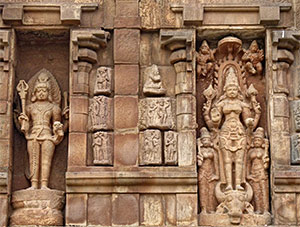 |
You can see the intricate details of the ornaments worn by the Goddess Lakshmi. She is flanked by two diminutive guardian nymphs. |
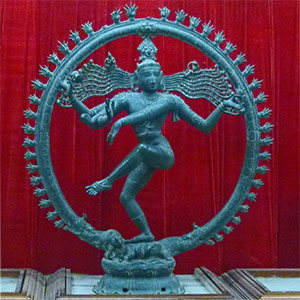 |
This Nataraja statue (from 10th Century AD) in bronze found in Vedaranyam in southern Tamil nadu is representative of Chola arts. |
This World Heritage UNESCO site - Big Temple bears the hallmark of 3 different dynasties - Chola, Nayaks and Marathas. You will see in this video - the magnificent grand stone edifice of the RajaRaja Chola, with additions of a monolithic Nandhi statue and Subramanya temple added by the Nayaks and Marathas.
Brihadisvara temple at Gangaikondacholisvaram
- This temple in Gangai Konda Chozhapuram (in Tamil it stands for the Town in honor of the One who conquered the Land around the river Ganga) is an extension to the passion of architecture held by the King Rajaraja Chola. King Rajendhra Chola has taken all efforts in replicating the work of the Thanjavur Brihadisvara temple here. This temple was built around the year 1020 AD. This temple is a little shorter when compared to the one in Thanjavur and depicts the Chalukya style of architecture and is built on southern granite.
- A ruined gopura greets people at the inner wall of the temple complex; the gopuras of the outer walls were ransacked long back.
- The Nandhi can be seen as you enter the temple though it is not as large as the one at Tanjavur. Forms of Lord Nataraja, dancing Ganesha, the coronation of King Rajendhra chola by Lord Shiva and Goddess Parvathi and Ardhanarisa are beautifully carved.
- The inner sanctum sanctorum has a Shivalinga that measures 5 meters in height. The sanctum is surrounded by two and was used as a private worship place by the Royal family.
Airavateswara temple at Darasuram
Named after the White Elephant of Indra, this temple is an exquisite testimony to the grand temple architecture of the Cholan Empire. It is the last of the 3 great Cholan temples built by successive generations of Kings starting from Rajaraja I. Airavateswara temple was built by Rajaraja II around 1150 AD. One of the striking features of this temple is Rajagambhira Thirumandapam - Royal Courtyard, with intricately carved pillars, long steps made of granite stones and elegant chariots drawn by horse - again hewn out of stone. You will see finer workmanship in this temple than the earlier temples. Darasuram is literally a stone's throw away from Kumbakonam.

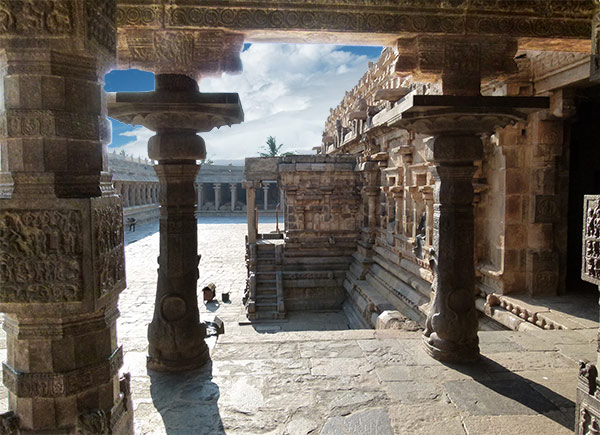


- The vimana or tower of this temple holds a lot of interest and measures 24 meters in height.
- The main idol housed in this temple is that of Lord Shiva.
Thanjavur is located 58 kms from Tiruchirapalli; the nearest town that has airport facility. Tiruchirapalli is well connected to Chennai and Madurai by regular flights. Thanjavur is well connected by rail to Trichy, Chennai, Madurai and other important towns in Tamilnadu. The road network is good to Thanjavur and there is a good network connected to other parts of the State. Darasuram and Gangaikondacholisvaram can be reached from Thanjavur or Trichy by road. The temples are open from 6 in the morning to noon and from 4 in the evening to 8 in the night.
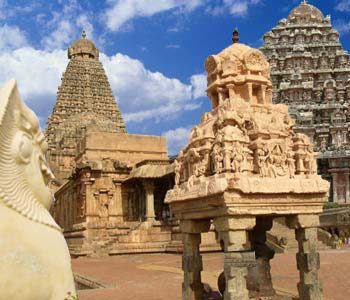
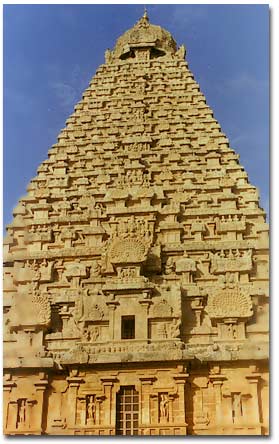
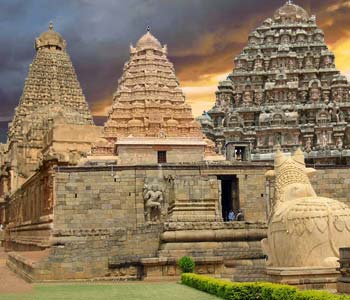
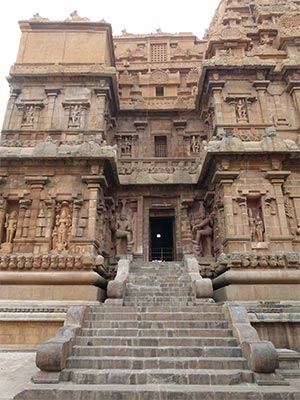
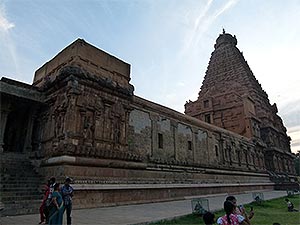
 Indian Temples - Information about temples in all their architectural grandeur
Indian Temples - Information about temples in all their architectural grandeur
 Belur Hoysala Temples - Poetry in Stone
Belur Hoysala Temples - Poetry in Stone
 Chola Temples - Revisit the past glory of the mighty Cholas
Chola Temples - Revisit the past glory of the mighty Cholas
 Madurai Meenakshi Temple - One of the Biggest temples
Madurai Meenakshi Temple - One of the Biggest temples
 Tirupati temple - Lord of the 7 Hills
Tirupati temple - Lord of the 7 Hills
 Rameshwaram Temple - Sethu Yathra
Rameshwaram Temple - Sethu Yathra
 Swamimalai Temple - The Son who taught his Father
Swamimalai Temple - The Son who taught his Father
 Guruvayur Temple - Bhuloka Vaikunta
Guruvayur Temple - Bhuloka Vaikunta
 Sabarimala Temple - Makara Jyothi
Sabarimala Temple - Makara Jyothi
 Padmanabha swamy Temple - Ananthasayanam
Padmanabha swamy Temple - Ananthasayanam
 God in Himalaya Mountains - Abode of Shiva and his consort Shakthi
God in Himalaya Mountains - Abode of Shiva and his consort Shakthi
 Char Dham - Most revered 4 temples of Hindu Pilgrimage in Himalayas
Char Dham - Most revered 4 temples of Hindu Pilgrimage in Himalayas
 Yamunotri - Yamunotri - dedicated to Goddess Yamuna
Yamunotri - Yamunotri - dedicated to Goddess Yamuna
 Gangotri - Holy destination that embodies the origins of the Ganga
Gangotri - Holy destination that embodies the origins of the Ganga
 Kedarnath - Kedarnath on the Garhwal Range built by Adi Shankaracharya
Kedarnath - Kedarnath on the Garhwal Range built by Adi Shankaracharya
 Badrinath - Badrinath dedicated to Vishnu - supreme God of Vaishnavites
Badrinath - Badrinath dedicated to Vishnu - supreme God of Vaishnavites
 Temples in Mathura and Vrindavan - Temples dedicated to Lord Krishna
Temples in Mathura and Vrindavan - Temples dedicated to Lord Krishna
 Temples in Dwarka - legend and lore that surround the temples in Dwarka
Temples in Dwarka - legend and lore that surround the temples in Dwarka
 Amritsar Golden Temple - In the Pool of the Nectar of Immortality
Amritsar Golden Temple - In the Pool of the Nectar of Immortality
 Vaishno Devi Temple - Shakti - Source of all Power
Vaishno Devi Temple - Shakti - Source of all Power
 Konark Sun Temple - Intricate sculptural work
Konark Sun Temple - Intricate sculptural work
 Khajuraho - Breathtaking sculptures of Khajuraho
Khajuraho - Breathtaking sculptures of Khajuraho
 Puri Jagannath Temple - 12 century Hindu Temple
Puri Jagannath Temple - 12 century Hindu Temple
 Kashi Vishwanath Temple - Temple in the oldest living city
Kashi Vishwanath Temple - Temple in the oldest living city
 Shirdi Temple - White marble temple
Shirdi Temple - White marble temple
 Thiruvannamalai temple - Padal PetraSthalam
Thiruvannamalai temple - Padal PetraSthalam
 Saradamba Temple Sringeri - Sringeri Temples
Saradamba Temple Sringeri - Sringeri Temples
 Ranganatha Swami Temple - Largest Temple in the World
Ranganatha Swami Temple - Largest Temple in the World
 Udupi Krishna Temple - Kanakanakindi
Udupi Krishna Temple - Kanakanakindi
 Vaitheeswaran Koil - Prime center for naadi shastra
Vaitheeswaran Koil - Prime center for naadi shastra
 Sripuram Golden Temple - Temple of Gold
Sripuram Golden Temple - Temple of Gold
 Sakshi Gopal Temple Puri - Witness by God
Sakshi Gopal Temple Puri - Witness by God
 Srikalahasti Temple - Kailas of the South
Srikalahasti Temple - Kailas of the South
 Kanchipuram Temple - Ancient Pallava built Temple
Kanchipuram Temple - Ancient Pallava built Temple
 Palani Temple - Temple dedicated to Tamil God
Palani Temple - Temple dedicated to Tamil God
 Thiruchendur Murugan Temple - Part of the 6 Abodes of Murugan
Thiruchendur Murugan Temple - Part of the 6 Abodes of Murugan

